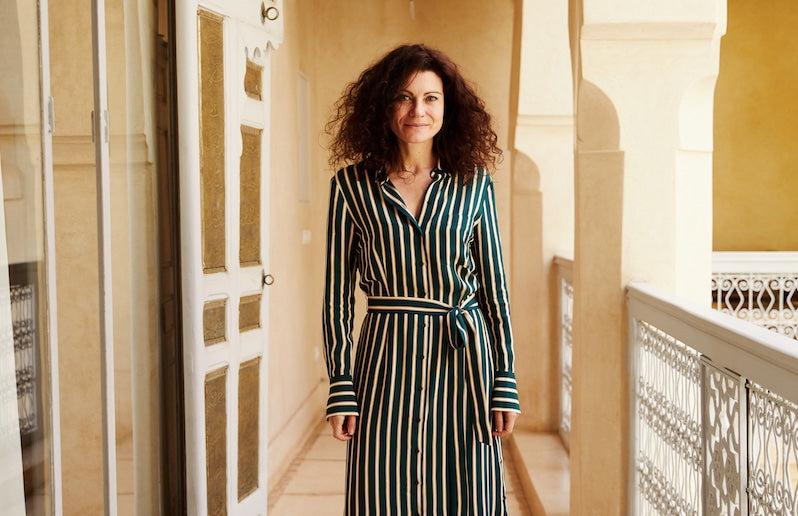In der Accessoires-Kollektion fallen sie durch ihre verspielten Farbtupfer auf, die wie kleine Regentropfen aneinandergereiht einen Kreis bilden. Diese besonderen Schmuckstücke, Tagua-Armbänder genannt, haben einen faszinierenden Ursprung: Bevor sie Fashionistas in aller Welt schmücken, wachsen die kleinen Tagua-Nuss Tropfen hoch oben in den Palmen des ecuadorianischen Regenwaldes.
 © Suzana Holtgrave for ABURY
© Suzana Holtgrave for ABURY
Von der Palme zum Armband – Der Weg der Tagua-Nuss
Wie wird aus der Frucht der Taguapalme ein kunstvolles Armband? Der Prozess der Herstellung von Tagua-Nuss-Schmuck ist eine Mischung aus handwerklichem Geschick, harter Arbeit und Tradition. Alles beginnt mit der Ernte der Tagua-Nüsse, oft in schwer zugänglichem Gelände in den Bergen Ecuadors. Die Palmenfrucht wird mit einer Machete geöffnet, im Inneren befindet sich das Herzstück unserer Armbänder: die Tagua-Nuss.
Nach der Ernte werden die Palmnüsse, geschliffen und mit organischen Pflanzenfarben gefärbt, um die leuchtenden, lebendigen Farbtöne zu erhalten, die unsere Armbänder so einzigartig machen. Jedes Stück ist ein handgefertigtes Unikat – und zugleich ein Meisterwerk ecuadorianischer Handwerkskunst.
 © Photos via Organic Tagua Jewelry
© Photos via Organic Tagua Jewelry
Gutes tun für Mensch, Tier und Umwelt
Die Tagua-Armbänder sind nicht nur modisch, sondern auch ökologisch und sozial nachhaltig. Die Palmen, von denen die Tagua-Nüsse stammen, wachsen jedes Jahr nach, so dass der gesamte Ernteprozess zu 100 Prozent nachhaltig ist. Die Abfälle der Tagua-Nüsse werden in den Dörfern, in denen die Armbänder hergestellt werden, als Viehfutter verwendet. Die für die Armbänder verwendeten Farben sind rein pflanzlich und frei von Chemikalien, was die Umwelt schont.
Aber nicht nur die Natur profitiert von Tagua-Nuss-Schmuck: Die Herstellung der Armbänder sichert den Kunsthandwerkerinnen und Kunsthandwerkern in Ecuador ein faires und regelmäßiges Einkommen. Für viele Familien in den Dörfern bedeutet dies eine stabilere Zukunft, bessere Bildungschancen für ihre Kinder und die Möglichkeit, ihr kulturelles Erbe weiterzugeben. In einem exklusiven Interview mit Soraya Cedeno, die Gründerin von Organic Tagua Jewelry, haben wir erfahren, warum Soraya es sich zur Lebensaufgabe gemacht hat, den Kunsthandwerkern in ihrer Heimat durch direkte, faire und nachhaltige Arbeit zu helfen.
© Video via Organic Tagua Jewelry
Tagua: Tradition und Moderne im perfekten Einklang
Tagua-Armbänder sind ein Symbol für die Schönheit Ecuadors, für die Verbindung von Tradition und Moderne und für nachhaltigen Wandel. Jede Nuss, jedes Armband erzählt eine – von den Tiefen des Regenwaldes bis zur Hand des Kunsthandwerkers oder der Kunsthandwerkerin, die es geschaffen hat.
Mit dem Kauf eines Tagua-Armbandes wird nicht nur der Erhalt traditioneller Handwerkskunst unterstützt, sondern auch der Schutz des Regenwaldes und seiner Tierwelt. Schmuck aus Tagua-Nüssen hilft sogar, bedrohte Tierarten wie Elefanten zu schützen, da die Nüsse eine nachhaltige Alternative zu Elfenbein bieten. So wird Tagua-Nuss Schmuck zur Bewegung für eine bessere Zukunft.
Naturschmuck mit Herz und Wirkung
Tagua-Armbänder sind ein Beispiel dafür, wie Mode, Kunsthandwerk und Nachhaltigkeit zusammenkommen können. Sie stehen für das Engagement einer Gemeinschaft, für die Schönheit des Regenwaldes und für die Hoffnung auf eine bessere Zukunft.
Die Kunsthandwerkerinnen und Kunsthandwerker, die Generationen von Wissen und Fertigkeiten in sich tragen, sind Hüter eines besonderen Erbes. Mit jedem Armband, das sie herstellen, tragen sie zur Stärkung ihrer Gemeinschaft und zum Erhalt der natürlichen Ressourcen bei.
 © Photo via Organic Tagua Jewelry
© Photo via Organic Tagua Jewelry




Share: